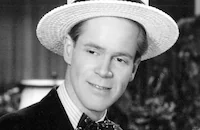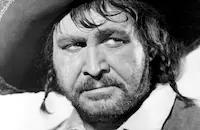Rails into Laramie

Cast & Crew
Jesse Hibbs
John Payne
Mari Blanchard
Dan Duryea
Joyce Mackenzie
Barton Maclane
Film Details
Technical Specs

Synopsis
In the Wyoming territory Vuring 1869, Union Army Sgt. Jefferson Harder enters a casino and, within minutes, instigates a brawl. Just as he is thrown through the window, the soldiers sent by Gen. Augur to bring Jeff back to the fort arrive. Back at the fort, Argur explains to the hot-headed officer that the construction of the cross-country railroad has been halted outside Laramie by Jim Shanessy, who runs the town and wants the crew to stay and spend their money at his hotel and casino. It is only the threat of the blockade that convinces Jeff to take the assignment. He is further annoyed when his arrival in Laramie is met with dismay from the chief railroad engineer, Lee Graham, Judge Pierce and Mayor Frank Logan, who expected him to bring troops. Graham, Pierce and Logan grow more aghast when Jeff warmly greets Shanessy, his childhood friend. Jim is at first pleased when Shanessy offers him free board at the hotel, but when the businessman's henchmen, brothers Con and Ace Winton, deliver a two-thousand dollar gift, Jeff recognizes it as a bribe. In the lobby, Jeff agrees to meet later that night with Pierce, who is still suspicious of him, and then visits the ineffectual but good-hearted marshal, Orrie Sommers, and advises him to ready the jail cells. At the casino soon after, Shanessy introduces Jeff to his partner, beautiful Lou Carter, but Jeff spurns Lou's advances and returns the money to Shanessy. Shanessy, who remains friendly even after Ace threatens Jeff and is beaten up in return, invites Jeff to his home, hoping that Jeff's lingering feelings for Shanessy's wife Helen will keep him from pursuing his new duties. Later, Jeff meets with Graham, Pierce and Logan, and then, armed with their promise of complete authority, visits the railroad work site, where the men are drinking, gambling and sleeping. After Jeff knocks out the brawny foreman, the other men back away, allowing him to shut down the makeshift saloon. The next day, however, when Jeff posts notices that all the men have been fired and construction suspended, both the workers and the town merchants complain bitterly. Graham calls a council meeting, at which some merchants demand Jeff's court-martial but, after he explains that he can rid the town of gambling and alcohol and only those who want to work will remain, they agree to give his plan a two-week trial. Shanessy counters by refusing to grant workers credit, and when they gather into an angry mob, as he has planned, he easily convinces them to wreak havoc on the town and defeat Jeff's plan. Jeff, however, arrests Shanessy, and that night, Lou invites Jeff to her room and, explaining that no local jury will convict Shanessy, offers to help. A mistrustful Jeff kisses her but then leaves. At the jail, Shanessy talks Jeff into visiting Helen, and when Jeff later leaves her house, too attracted to her to stay, he is beaten and deposited into a railroad car by Shanessy's men. In the morning, Jeff's absence results in a mistrial. Shanessy then instructs the workers to burn down all the railroad camps, after which every arrest Jeff makes is dismissed by crooked juries. He then sends for backup troops, but Shanessy shuts down the telegraph and, anticipating that Jeff will travel to see Augur himself, creates a landslide that blocks all traffic. Graham, Pierce and Logan insist that Jeff rehire the workers, and when he refuses, they send Orrie on horseback to Cheyenne to order Jeff court-martialed. Soon after, Jeff discovers that Orrie has been killed on the trail, and Lou informs him that Shanessy is the culprit, but the only way to convict him is to construct a jury out of the Wyoming women who have just been granted the right to vote. Still skeptical, Jeff visits Shanessy, and when Ace pulls out a gun, Jeff shoots him and arrests Shanessy again. This time, Lou sits as foreperson on the female jury, and, to Shanessy's shock, they find him guilty. Jeff thanks Lou afterward, and although she first spurns him, he grabs her and she falls into his arms. The night before Shanessy's scheduled hanging, Helen slips him a gun, and with it he knocks out Jeff and races to Lou's, shooting her in the back. Jeff revives and gathers a posse while Shanessy commandeers a train to Cheyenne, not realizing that the landslide has just been cleared on the tracks, and a passenger train is headed straight toward him. Jeff rides to Shanessy's train, leaps on and shoots his way to the front. There, with the passenger train fast approaching, he knocks out Shanessy and reverses the train only moments before a collision. Weeks later, railroad construction has resumed, and Jeff reports to a recovering Lou that although he must return to the Army for six months, he will consider Laramie his home base.

Director
Jesse Hibbs
Cast

John Payne

Mari Blanchard

Dan Duryea

Joyce Mackenzie

Barton Maclane
Ralph Dumke
Harry Shannon

James Griffith

Lee Van Cleef
Myron Healey
Charles Horvath
George Chandler

Douglas Kennedy
Alexander Campbell
Race Gentry
Christiane Martel
Myrna Hansen
Synove Gulbrandsen
Alicia Ibanez
Stephen Chase
John Harmon
Gayne Whitman
Paul Mcguire
Forrest Taylor

Ken Macdonald
Frank Scannell
Hal K. Dawson
John Cliff
Rex Lease
Ric Roman
Larry Hudson
Mitchell Kowal
Scott Lee
Roy Butler
Gilbert Fallman
Tim Graham
Paul Brinegar
Jack M. Lomas
Harold Tommy Hart
Jack Wilson
Anthony Jochim
Ferris Taylor
Matt Winston
Robert Keys
Max Wagner
Bruno Ve Sota
Rusty Wescoatt
Frederick Foote
Hugh Lawrence
Bob Templeton
Paul Savage
Brick Sullivan
Wayne Berk
Pat Bradley
David Dyer
Howard Gould
Ray Quinn
Monte Pittman
Jack Gargan
Lee Douglas
Ned Davenport
Bill Sundholm
Tex Terry
Don Nagel
Joel Allen
Crew
D. D. Beauchamp
Phil Bowles
Leslie I. Carey
Borden Chase
Robert Clatworthy
Richard Deweese
William Fritzsche
Russell A. Gausman
Joseph Gershenson
Maury Gertsman
Harold Goodwin
Frederick Herbert
Julia Heron
Bernard Herzbrun
Joseph Hoffman
Arnold Hughes
Leo Katcher
Ted J. Kent
Ted Richmond
Tom Shaw
Luanna Sherman
Joan St. Oegger
Dewey Starkey
Bill Thomas
Bud Westmore

Film Details
Technical Specs

Articles
Rails into Laramie
The classic Western saw its most prolific period in the mid-century, before changes in American life and thought saw the birth of the revisionist cinema of Hellman and Peckinpah and various genre offshoots, while overseas Leone and Corbucci lent the genre a bloody twist.
Among the hundreds upon hundreds of Westerns released in the 1940s and '50s few titles seem to stand out. There are masterpieces among them, those that are forgettable and others that are harder to watch now, given their skewed portrayal of Native Americans. But overall, they gave us the lonesome cowboy trope: the hero on a horse, the rider fading into the sunset. But perhaps more importantly--and much more fun--they bred the ultimate baddies.
Rails Into Laramie (1954) isn't a special picture by any means. It's directed through its twists and turns by the steady hand of Jesse Hibbs, who in later year had an extremely prolific career on the small screen with credits on Perry Mason and Gunsmoke. It's got a reliable lead in John Payne, who, in the next year would go on to film two other transportation-theme-titled Westerns (Santa Fe Passage and The Road to Denver, both as memorable as their names suggest). But the wild card in the stack was supporting actor Dan Duryea.
In Hollywood--as in history--the West was a place where a man could reinvent himself. Tired of his life on the East Coast, he could pack his bags and light out for the territory. If he made it past the vast stretches of plains, the rattlesnakes and coyotes, territorial tribes and the brutal heat, well, then he had to do his best to not tick anybody off and find a bullet in the back. But--the main thing was he was here, and here he wasn't who he used to be.
Duryea began his career working in advertising until he couldn't take it anymore. He turned to his true passion for acting, a vocation which proved to be his meaning in life. He quickly made up for lost time, and pretty soon he found himself on the other side of James Stewart, Gary Cooper, Burt Lancaster and Edward G. Robinson, and over the course of a 100 plus credit career made a name for himself as a go-to heavy, the man who had the good looks and sinister sneer who'd shoot with a smile on his face.
In genres oversaturated with archetype and plot, the work of character actors shines through. Duryea gave a special spark to the noir and Western canons, and it's quite fun to see him let loose, especially in a thrilling climax set on a moving train. While Laramie as a standalone film isn't particularly memorable, it's the work of actors like Duryea who add color and texture to the canvas of the West in all its history and mythology.
By Thomas Davant

Rails into Laramie
Quotes
Trivia
Notes
The working title of this film was Fort Laramie. As depicted in the film, in 1869, Wyoming became the first state to grant women the right to vote, and the first all-woman jury served in that state in 1870. According to Universal press materials, some scenes were shot in Mojave, CA. The Los Angeles Examiner review refers to star John Payne as "John Wayne."














